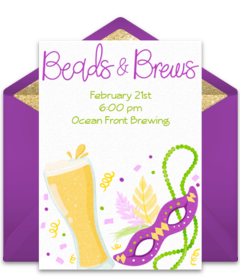Mardi Gras Traditions
Mardi Gras is a fun and exciting time of the year. Between the music, parades, floats, and food, it is no wonder why so many people travel to New Orleans each year to take part in the festivities. Mardi Gras is also celebrated in other parts of the world including Belgium, Canada, Italy, Germany, Sweden, the Netherlands, Brazil, and Australia.
There are many traditions that are associated with Mardi Gras. Many of these traditions have been followed for centuries and some have been adapted over the years. One thing is for sure, each of the Mardi Gras traditions observed in New Orleans is an essential part of the carnival festivities!
- Schedule: Fat Tuesday always falls on the day before Ash Wednesday, the start of lent. This date can be anytime between February 3 and March 9, depending on the Catholic Church. The carnival season begins approximately two weeks before Fat Tuesday. During this time, people attend the parades, festivals, and parties that are associated with Mardi Gras.
- Costumes: In New Orleans, it is a Mardi Gras tradition to dress up in multicolored fabrics, masks, and hats. The capuchon is a popular type of hat that is entirely associated with Mardi Gras traditions in New Orleans. This hat is shaped like a cone and is decorated with bright colors, designs, and textures. Check out these Mardi Gras costume ideas if you feel like dressing up to celebrate.
- Parades: Another important Mardi Gras tradition is the parades. The parades began in New Orleans around the 1830’s. In 1872, Rex, the King of the Carnival, came up with the idea to make the parades into a spectacular show. Bands, parade floats, costumes, and beads were added and more parades were put on throughout the carnival season.
- Colors: The traditional colors of Mardi Gras were chosen in 1872 by Rex, the King of Carnival. The three colors are purple (representing justice), gold (signifying power), and green (symbolizing faith).
- Masks: Masks are seen throughout the streets of New Orleans during Mardi Gras as well as at masquerade balls. They were originally worn as a way to protect oneself from the devil or other evil spirits. Though these superstitious beliefs are no longer associated with the masks, the masks are still an essential part of the carnival celebration. Intrigued? Check out how to make your own Mardi Gras mask.
- Food: The phrase “Mardi Gras” literally translates to mean “Fat Tuesday” in English. The name stems from the tradition of feasting up until the stroke of midnight on Tuesday when Lent begins. Pancakes are a common food to eat during the feast. It is also a tradition to toss the pancakes with a coin in one hand in order to ensure prosperity throughout the year. Other common Mardi Gras foods are King Cakes, beignets, gumbo, jambalaya, and grits.
- Carnival Ball: This masquerade ball is the climax of the carnival season of Mardi Gras. This annual event is by invitation only in order to keep the Mardi Gras traditions of the krewe secret.
- Mardi Gras terminology: There are many words and phrases associated with Mardi Gras that may not be well known to everyone. A “doubloon” is an aluminum coin that is imprinted with the insignia of the parade crew on one side and the theme of the parade on the other. The “krewe” is the organization that puts on the parade. The “flambeaux” are torches that are carried during the Mardi Gras parades. “Fat Tuesday” is the final day of the carnival season associated with numerous parades, parties, and festivals.
Hosting a Mardi Gras party? Be sure to send online Mardi Gras invitations to set the stage for your event, quickly manage RSVPs, and communicate with your guests.



 Love this article?
Love this article?